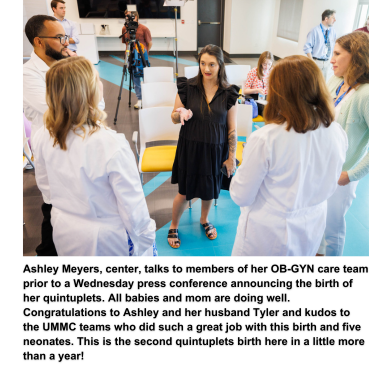Dependable Consistency
Good morning!
We are now rolling in the new fiscal/academic year, which will be my 10th as vice chancellor. We are positioned to make good progress on our goals. (I cringe a little each time I make a prognostication like that after making a similar claim in January 2020.)

We are in a strong financial position and I’m seeing good progress in all three mission areas. We will expand our health system this year in the form of new clinics in UMMC Colony Park South, the reopening of the Children’s Center for Cancer and Blood Disorders on the bottom floor of the Batson Tower and new med-surg and ICU beds soon coming online that I’ve mentioned in past columns. I’m looking forward to seeing all we will accomplish this year.
As I contemplate the positive position in which we start this new fiscal year, I’m mindful of how delicately balanced everything is and how much needs to line up to make significant strides on our goals. We are a large organization and the margins in all our mission areas are tight. That’s going to nearly always be the case for an academic medical center – especially one that is unique within the state it serves. We are many cutting-edge, complicated, coordinated components that all work together to make the machine run.
In one of my earliest VC Notes – April 17, 2015, the second month of my tenure – I shared my thoughts on the question, “Who Are We?”. I think what I said then is very true today and will be true for the entire existence of this Medical Center.
Which statement is true: UMMC is a….
Primary care provider
Safety net hospital
Educator of health professionals
Center for scientific discovery
Tertiary referral center
Nonprofit health system
University campus
State agency
It's a trick question because all are true.
All of these roles are part and parcel of most public, academic health science centers, which have been described as the most complex organizations in the world.
This complexity has advantages and disadvantages. On the one hand, it's what makes academic health science centers such as ours so consequential in our world today. When you add up all the good we do in our state through our missions of education, research and health care, it's pretty amazing. Add to that our multi-billion-dollar annual economic impact and few institutions in our society can match what we deliver.
On the other hand, managing this complexity can be a tall order.
Think about this….
We are expected to operate nimbly in a volatile business environment, but we have to comply with state procurement regulations that are better suited for the purchase of highway culverts.
We are part of a university, but some of the traditions of the university seem to clash with our go-go business imperative.
Our systems infrastructure, facilities and workforce have to accommodate the most complex surgical procedures imaginable in a tertiary hospital, alongside the high-touch, low-tech primary care provided in a community clinic, and allow us to excel at both.
While the diversity of our missions and activities can be a source of resilience, this diversity can also put us at odds with one another as well as with external players. Within UMMC, there are tensions at times between the components of “who we are” noted above. Often those tensions center on the need to allocate limited resources – typically money, but other resources as well. There's also the inevitable friction between the subcultures that populate our world – doctors, nurses, therapists, researchers, educators, clinicians, administrators, blue collar, white collar…to name a few.
Reconciling these diverse interests is a big job. It's my job, principally, but it falls to everybody to understand our complex makeup and to recognize that for UMMC to be successful, everybody has to give a little and look for and honor the common ground of our shared purpose.
The payoff is that our future will be all the brighter. Guided by our strategic plan, we are in the process of transforming our core mission areas to engender more team-based learning, more clinical and population-based research, and higher quality care delivered more efficiently.
Our plan also recognizes that as effective and influential as we may be, we cannot hope to move Mississippi's health status off the bottom nationally by acting alone. We will have to work with other organizations, both public and private, to have significant positive statewide impact.
Inevitably, there will be distractions and disruptions along the way. But we must stay true to who we are – as complicated and confounding as that can sometimes be – on our path to A Healthier Mississippi.



